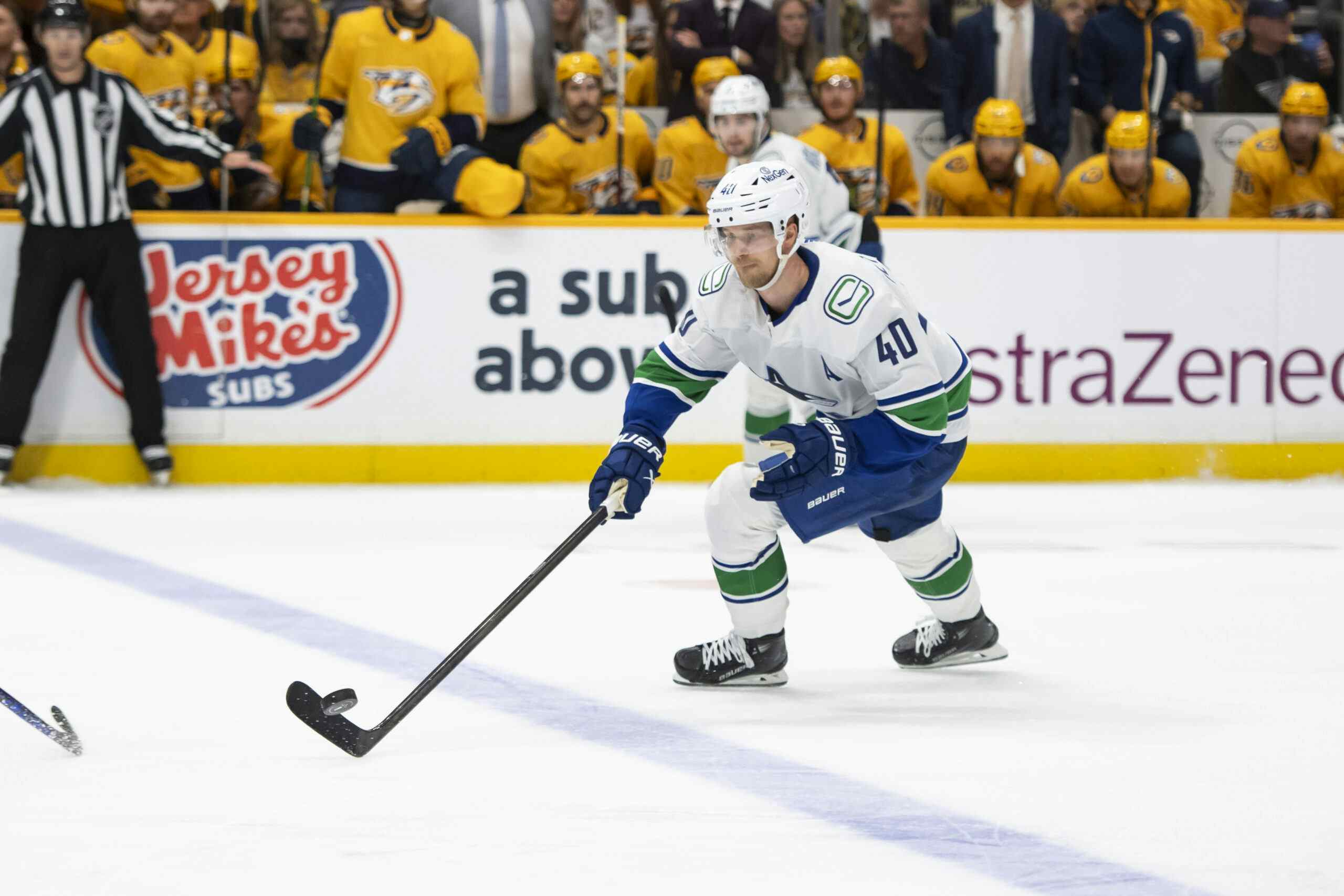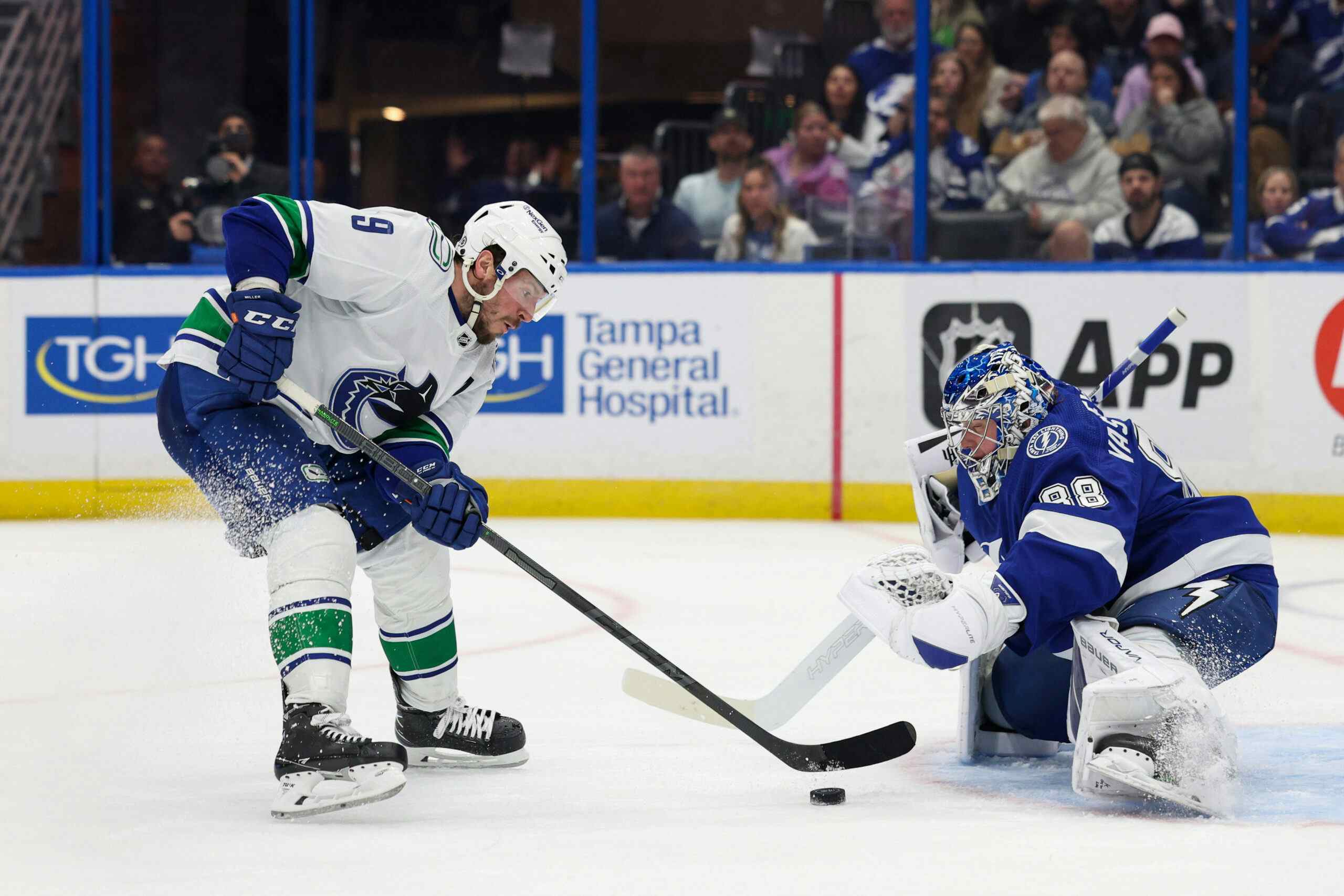Markus Granlund Isn’t The Problem, It’s Your Expectations
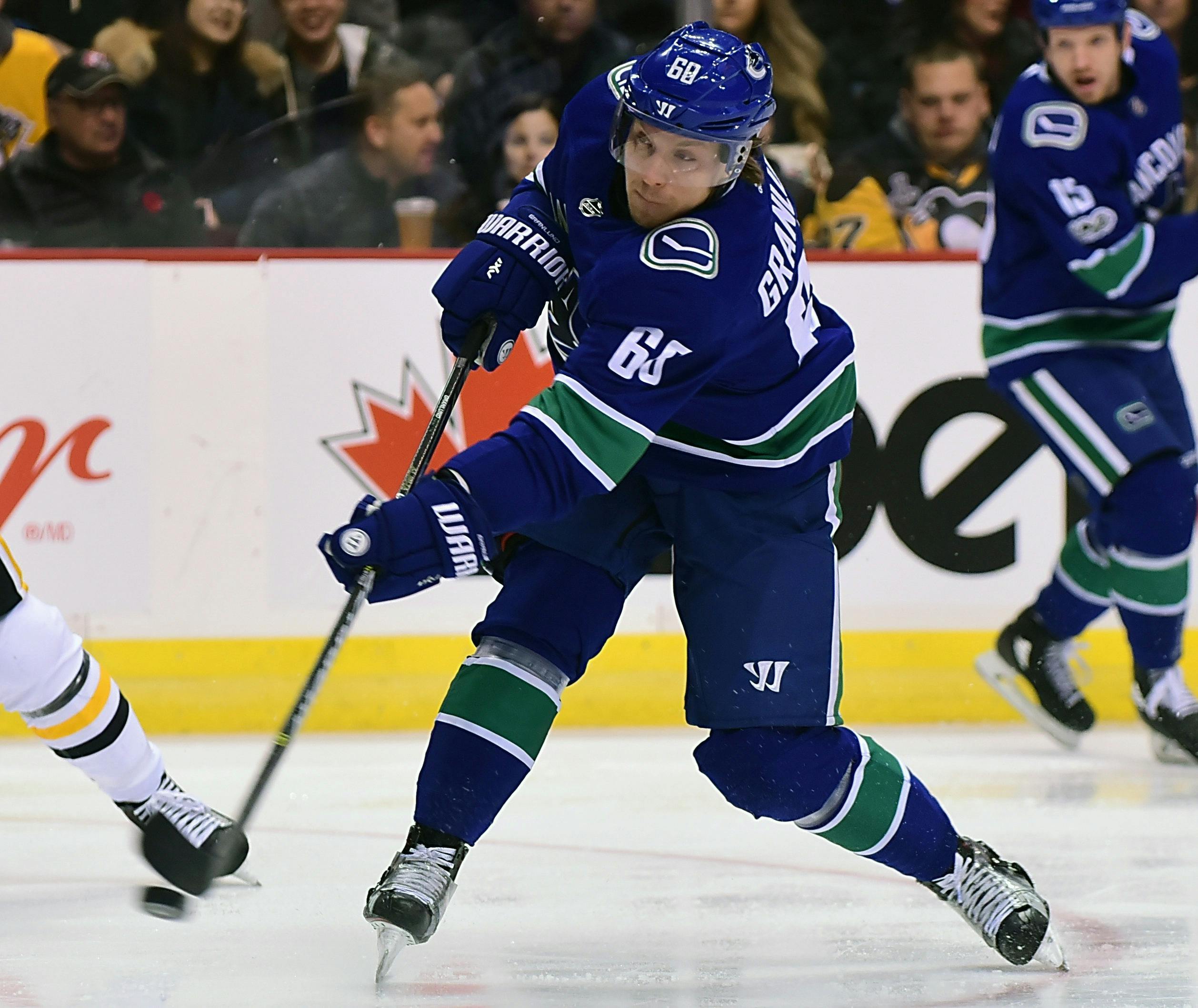
6 years ago
Obviously, the biggest story of the season has been Brock Boeser, and by extension, the play of fellow youngsters and linemates Bo Horvat and Sven Baertschi.
Another young forward has also been a story this season, for all the wrong reasons. After a 19-goal, 32-point performance in 2016-17, Markus Granlund has just four points in 21 games this season.
Granlund was one of the lone bright spots in an abysmal 2016-17 season that saw the Canucks finish 29th overall in the league, with a goals-for total to match. That’s part of the reason why Granlund road into this season on a wave of cautious optimism. There was buzz. Jeff Paterson predicted he would lead the team in goals this season. But from the moment he hit the ice this season, it was apparent something had changed.
We’re past the quarter-mark of the season, which means that fans and media alike feel comfortable to begin drawing conclusions about who has played well and who hasn’t, and boy, a lot of people sure seem to think Granlund hasn’t.
First, there was our own JD Burke.
Then Botch weighed in.
“Granlund has been a ghost for 20 games. Had an outstanding year last year. Lots of guys have one really good year, and then that’s it… they don’t approach that again. Well I want to know if I’m the Canucks… what Granlund… can be and is… now I don’t have a clue. Last year I really liked his energy, I liked the plays that he made. This year it looks like he’ll never score again.”
Yes, it’s true that Markus Granlund has been a disappointment this season compared to last; but that has as much to do with expectations as it does with his play. Things have been vastly different for Granlund, for a myriad of reasons. To begin, let’s look at last season.
The Past
I think before we go any further, I should deliver a mea culpa on behalf of CanucksArmy. We should have been on this way sooner — on even a surface level, it was obvious that Markus Granlund’s production was inflated last season.
I don’t have any experience in psychoanalysis, but if I were to speculate as to why we all slept on this, I’d say it has a bit to do with the circumstances under which Granlund joined the team some time ago. The Canucks acquired Granlund in a controversial trade that saw top prospect Hunter Shinkaruk go the other way, and CanucksArmy, along with most fans, were unenthused. At this stage, it’s looking like we’ll have to take the “L” on that one. For better or worse, Granlund is an NHL player. Shinkaruk, on the other hand, hasn’t lived up to the hype of his draft-season, even at the AHL level.
It’s rare for a player with Granlund’s history up until that point to suddenly break out the way he did. For that reason, we were all a little quiet about the fact that he finished the season having converted 15.6% of his shots. The only player who can count on doing that consistently is Steven Stamkos. If Granlund had finished with a league-average shooting percentage, he would have finished the season with around 12 goals in 69 games. Even over a full season, that works out to only 14-15 goals. Something tells me we aren’t the least bit surprised with his start if he had finished the season with his expected goal total.
On the other hand, Markus Granlund also managed those 19 goals all with a bum wrist, while playing with an offensive anchor in Brandon Sutter. JD was quick to point that out:
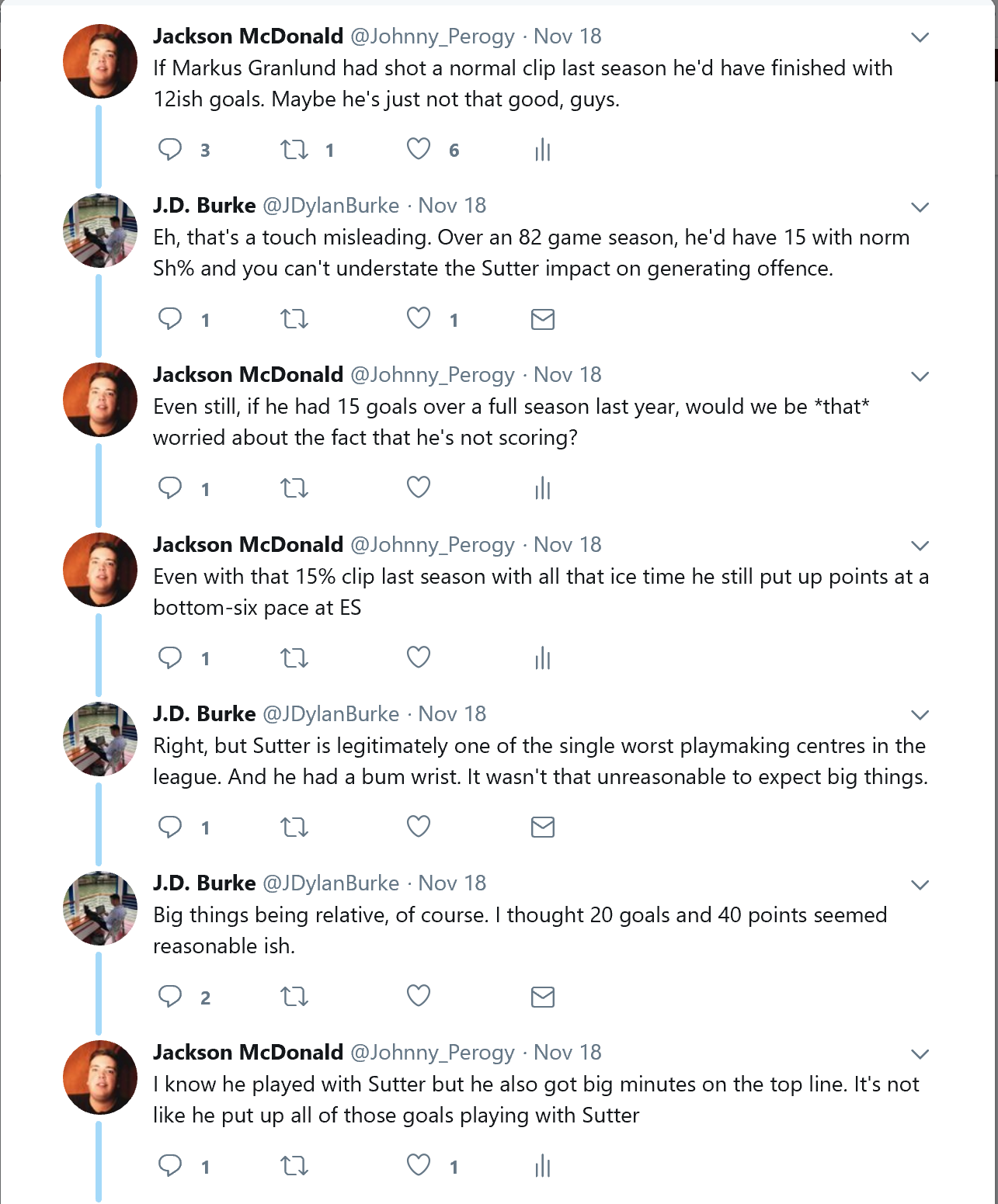
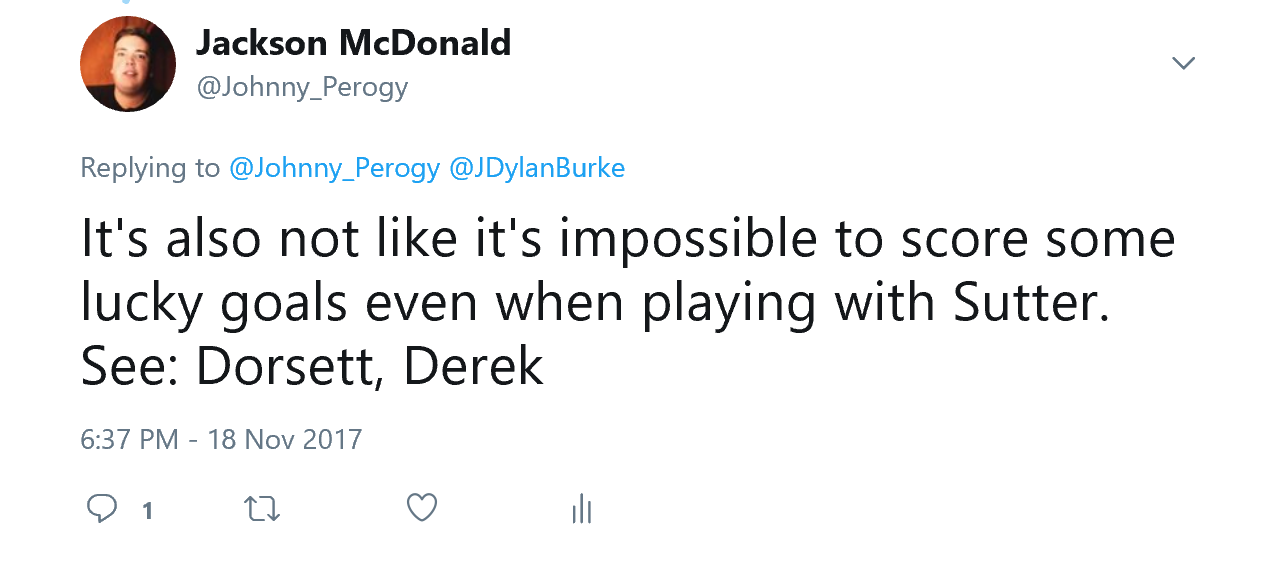
This interaction got me thinking: How did Granlund score his goals last season? With whom did he play? Since Corsica’s WOWY function is still a work in progress, I had to employ the good old-fashioned eye test to find out. Thankfully, we have YouTube for that.
Failed to load video.
I wanted to see if my hunch was correct, so I went back and looked at each of Granlund’s goals from last season. For now, we’ll omit the power play goals, because different factors go into producing with the man advantage — don’t worry, we’ll get to that later. Here’s how the goals break down:
Goal #1: There’s a bit of a defensive breakdown here, and the Canucks can take advantage. Jannik Hansen has a nice pass here, and Granlund does a good job reading the play and heading straight to the net. There’s not a lot of art to it, but Granlund gets full credit for getting where he needs to be.
Goal #2: This one is another example of Granlund going straight to the front of the net to bat one in. Coaches will love that, but he gets a little lucky here. Most of the credit has to go to Hansen for using his speed to get the breakaway and create a rebound for Granlund.
Goal #4: This one comes at three-on-three. We’ll include it because it’s still a different animal from the man advantage. Sutter wins the faceoff, and Granlund is able to get the shot off quick. This is going to become a pattern. We’ll get to that in a minute.
Goal #5: Again, Granlund gets right into the goalie’s kitchen and is able to bat the puck out of mid-air and past Lundqvist. I wouldn’t quite call it pure luck, but it’s also not something that’s easily repeatable.
Goal # 6: This one’s right off a won faceoff again, but this time Granlund goes straight to the net and Eriksson feeds him from behind the net. This is just good execution by the entire line.
Goal #7: This one’s a bit of a gift. Jacob Trouba puts the puck right on Eriksson’s stick, and he’s able to feed a wide-open Granlund, who makes no mistake.
Goal #9: Tip-in. This one is tough to gauge. It looks like it may have hit the Flames defenceman on the way. They can’t all be pretty.
Goal #11: This one is similar to #6. Once again Sutter wins the faceoff and Granlund goes straight to the net to get it through the pads.
Goal #12: The broadcasters generously describe this play as a “steal”, but this is an unforced error by Nikita Zadorov. He turns the puck over behind the net and Granlund pulls off a nice move to catch the goalie off guard. Granlund gets full credit for pressuring Zadorov and fooling the goalie, but you don’t get gift-wrapped opportunities like this one on a regular basis.
Goal #13: Yet another goal straight off a won faceoff. This one is goal #4’s five-on-five cousin. He’s able to use his quick release to put the puck past the Predators’ goaltender before anyone else even knows what’s happening.
Goal #15: Another tip-in. This time, there’s no question. Full credit to Granlund for executing.
Goal #16: Granlund does a good job getting open here, but this is a classic Sedin set-up. A great example of the twins working their magic to open up space and find the soft areas of the ice.
Goal #17: This one comes on a three-on-one. Gaunce and Sutter are the other two players, so Granlund holds on to the puck the entire time.
Goal #18: This one comes off the rush. It’s a great cross-ice feed by Henrik, but Granlund also gets off a good shot here.
Goal #19: This one is all Henrik and Daniel. Off the rush, Henrik makes a beautiful cross-ice pass to Daniel, who feeds it through traffic to set up Granlund. By this point, the goaltender is completely discombobulated, and it’s an easy tap-in.
Going back and looking at these goals, I had a few observations. The first was how many garbage goals Granlund had last season. That’s not a bad thing, that’s how most players score in today’s NHL. I just think a lot of people remember the flashes of one-shot scoring Granlund showed last year. In reality, there were a lot more rebounds and a lot of jabbing at loose pucks in the blue paint. That puts the “bum wrist” aspect in context a bit. Granlund’s goals relied a lot less on his shot last season than I think people realize.
The second takeaway I had was just how many goals Granlund scored right off the faceoff. This doesn’t strike me as easily repeatable for a couple of reasons. First, if it’s a set play, that’s something teams eventually get wise to and start to adjust. Second, there are just so many factors that have to go the Canucks way for these plays to succeed. The centre (Brandon Sutter, in all of these cases,) has to win the faceoff and get the puck to Granlund immediately, and then Granlund has to get the shot off quickly enough to fool the goaltender. It’s also worth noting that the clean shots Granlund was able to get off the faceoff came against Kari Lehtonen and Pekka Rinne, who are both known to be behind the eight-ball at times. Given the randomness of faceoffs and the traffic and chaos that usually ensues in the immediate aftermath, it feels like you can only go back to this well so many times. Unfortunately, there’s a dearth of data and study on the subject, so I don’t feel comfortable coming to a firm conclusion yet, so it remains a hunch.
What stands out about these goals is just how differently Sutter and Granlund were used last season. The importance of zone starts is often greatly overstated, but I think it’s important when considering this particular play because you have to be starting in the offensive zone to execute it. Desjardins liked to dole out zone starts pretty evenly, and in this case, I think it greatly benefited the Sutter-Granlund combo. Sutter generally struggles to generate zone time because of his poor playmaking ability. This is perhaps most notable in transition.
Throughout his career, Sutter has resorted to dump-ins to gain the zone. More often than not, this meant the puck would spend only a few seconds in the offensive zone before it was sent the other way by the opponent. Starting Sutter in the offensive zone went a long way towards mitigating this. Travis Green, on the other hand, has used the Sutter-Granlund combo in a completely different role that not only doesn’t emphasize offence but also rarely allows them to execute a play that they got a lot of mileage out of last season. This means that even if scoring a goal right off a faceoff is a repeatable skill, Granlund isn’t being put in the position to do it to the degree he was last season.
Finally, Granlund was far from the only person creating offence when he was on the ice. Sure, he played a lot with Sutter, who was a complete non-factor on a lot of these goals; but almost all of his minutes with Sutter also came with one of Loui Eriksson or Jannik Hansen, who are both capable of creating offence and had a couple of nice set-ups for Granlund over the course of last season.
If you look at who got the primary assists on Granlund’s goals last season, you’ll see that eight of his goals were assisted by Eriksson, Bo Horvat, or the Sedins. That’s why I don’t think we need to adjust too much for the fact that Granlund spent so much time with Brandon Sutter.
Moving Forward

There are a couple of key differences this season with regards to Granlund. When he had his breakout year, Willie Desjardins had one of the worst offences in the league to work with, and to make matters worse; he didn’t exactly know how to use what he did have. This year not only do the Canucks have a new coach who seems to have a way better idea of how to get the most out of his players, but they also have a lot of new faces at forward. The Canucks prioritized offence this summer, signing Thomas Vanek and Sam Gagner. They’ve also added a lights-out Brock Boeser to their lineup. All these factors mean that Granlund’s usage has been very different from last season.
In 2016-17, Markus Granlund was the Canucks sixth-most used forward on the man advantage (131 minutes), just a few minutes ahead of Sven Baertschi. He rewarded Willie Desjardins by being the Canucks second-most productive forward per minute at 5-on 4, scoring four goals and four assists. This season, Granlund is the Canucks ninth-most used forward, and is on pace to see just over a third of the power play minutes he saw last season. Perhaps more importantly, the emergence of Brock Boeser virtually guarantees Granlund won’t be seeing any time with Horvat on the man advantage. That’s unfortunate for him because the Horvat-Granlund duo was a relatively productive one at 5-on-4 last year.
At even-strength, it’s more or less the same story. This season, Granlund is on pace to spend less than 2/3 of the time even-strength time he spent with Eriksson in 2016-17. He’s played 9 minutes at evens with the Sedins, and six with Bo Horvat. That’s not exactly a recipe for another 19-goal season.
So, what should we expect from Markus Granlund this season?
First of all, I think it’s clear that expecting Granlund to have a repeat of last year was unfair from the get-go, given his usage. The idea that Granlund was carrying his line offensively is a myth, at least when you look at the results.
Goals can be pretty random; but for whatever it’s worth, Granlund has been deprived of a lot of the things that made him successful last season.
That’s actually a good thing.
Part of the reason Markus Granlund had such a good year last season is that the Canucks just didn’t have anybody else to fill his role. He got more offensive opportunities, more minutes, and better linemates than he probably deserved, and he was able to capitalize. This season, the Canucks have better players to give those opportunities, and Granlund has been left playing with some of the team’s least offensively gifted players.
Believe it or not, he’s been fine, all things considered. Thus far, Markus Granlund has played most of his even-strength minutes this season with Derek Dorsett and Brandon Sutter. Here’s how those players have fared with each other, according to natural stat trick:

Not great, right? Well, here’s how those players fared without Markus Granlund:


This is far from a representative sample, but something tells me Granlund might not be the only problem here.
There’s no denying that he hasn’t been at his best this season. But he’s also kept up one thing he was able to do last year: drag Sutter kicking and screaming towards a respectable shot-share. That has to be worth something.
To be clear, I’m not trying to make the case that Markus Granlund has been good this season. He very clearly hasn’t. But what did you expect? He shot over 15% last season. He’s seen next to no PP time, played most of the season without a playmaker, and given who’s in front of him on the depth chart it’s been completely justified.
Granlund is on pace for 12 goals this season. He probably should have only had 15 last year.
Maybe that’s just what Granlund is: a 12-15 goal, bottom-six utility player.
And that’s fine.



